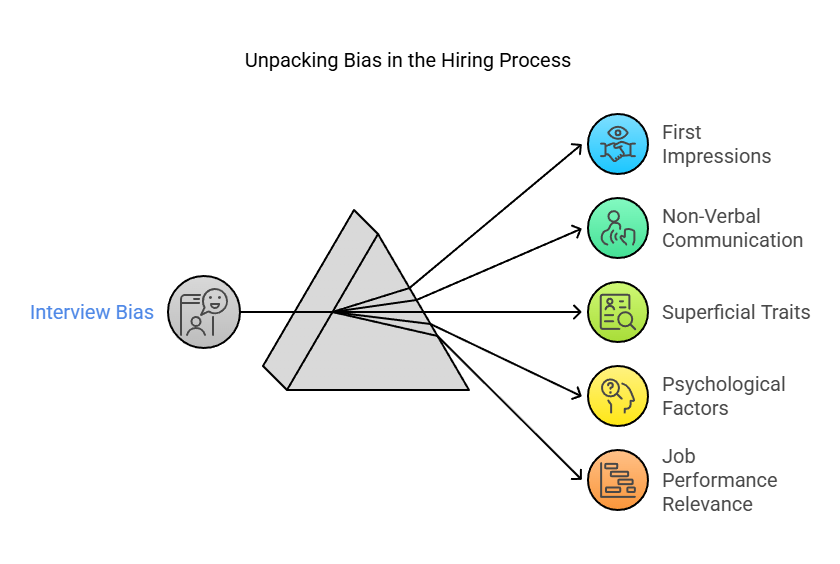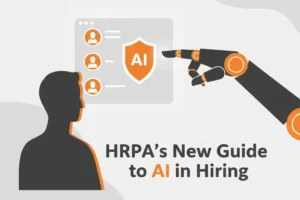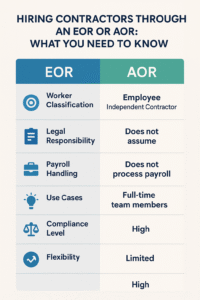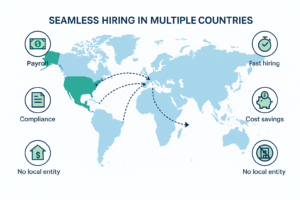Traditional Interviews Fail to Predict Job Performance
Hiring the right person is one of the most important decisions a business can make. Yet, traditional interviews often prioritize superficial traits—like confidence, charm, or appearance—over true competence. When a bad hire slips through, it can cost companies time, productivity, and morale. So, why do interviews still dominate the hiring process, and what can we do better?
In this blog, we’ll explore how unconscious biases influence interviews, what science says about better hiring methods, and how you can reduce costly hiring mistakes.
Interviews Are Riddled with Biases
1. First Impressions Override Substance
Human beings are naturally wired to make quick judgments. In interviews, this often means forming an impression within the first few seconds based on the candidate’s appearance, handshake, posture, or voice. Research by Ambady & Rosenthal (1993) found that observers could make highly consistent personality judgments from 30-second silent video clips of teachers. This concept, known as “thin slicing,” shows just how quickly we form impressions—and why this can be dangerous in hiring.
2. The Halo Effect
If a candidate is attractive or well-spoken, we tend to attribute other positive traits to them, like intelligence or reliability. This is called the halo effect. A meta-analysis by Hosoda, Stone-Romero & Coats (2003) confirmed that physically attractive individuals tend to be rated more favorably in job interviews—regardless of their actual qualifications.
3. The Similarity Bias
Interviewers often feel more comfortable with people who resemble them in background, values, or communication style. This leads to a preference for hiring people who “fit” the company culture—which may unconsciously exclude diverse candidates. Rivera (2012) found that interviewers favored candidates with whom they shared similar extracurricular interests or upbringing over equally qualified others.
4. Confidence ≠ Competence
Many people mistake confidence for capability. Extroverted candidates who speak with energy and certainty tend to be seen as more competent—even if their actual performance doesn’t match. Introverts or non-native speakers, who may be equally or more skilled, often get overlooked. This overreliance on social performance creates false positives.
5. Unstructured Interviews Are Unreliable
Schmidt & Hunter’s (1998) famous meta-analysis revealed that unstructured interviews have low predictive validity for job performance. They found that general mental ability (GMA) tests, combined with structured interviews or work samples, are far better predictors.

Real-World Consequences
Hiring based on bias doesn’t just affect the candidate—it impacts your whole organization. A wrong hire can:
- Reduce team morale
- Create friction among colleagues
- Lower productivity
- Increase turnover
According to a CareerBuilder study, 74% of employers say they’ve hired the wrong person for a position. The average cost of a bad hire can be as much as $14,900. These mistakes are expensive and avoidable.
Gallup’s State of the American Manager report (2015) revealed that managers are responsible for 70% of the variance in employee engagement. If your interview process places someone incompetent in a managerial role, the fallout can be massive—not just financially but culturally.
What the Science Says Works Better
So, what actually works?
1. Structured Interviews
These interviews ask every candidate the same set of questions, with scoring rubrics for each. This reduces the effect of first impressions or personal bias. Structured interviews have much higher predictive validity (around 0.51) compared to unstructured ones (around 0.38), according to Schmidt & Hunter (1998).
2. Work Sample Tests
Instead of asking “How would you handle this situation?”, ask them to do it. Can they write, design, or manage as needed? Work samples simulate job tasks and test candidates based on actual performance.
3. Cognitive Ability Tests
General mental ability (GMA) tests are among the most reliable predictors of job success. They measure problem-solving, learning ability, and critical thinking—skills that matter across industries.
4. Personality Assessments
Traits like conscientiousness and emotional stability are strong indicators of job performance. Conscientious employees are dependable and persistent, while emotionally stable employees manage stress well.
5. Blind Hiring Practices
Removing names, photos, and even educational institutions from resumes can help reduce implicit bias in the early stages of screening. Some companies also anonymize assessments to judge purely on merit.
Jordan Peterson’s Take on the Interview Trap
Jordan B. Peterson, a clinical psychologist and former University of Toronto professor, has spoken extensively on why face-to-face interviews are flawed. In one of his Personality and Its Transformations lectures, he notes:
“Tall, good-looking, extroverted people tend to do much better in interviews than short, unattractive, introverted people. And none of that has anything to do with job performance.”
He points out that the most predictive hiring tools are cognitive tests and personality assessments—not gut feelings or charisma.
He also critiques the over-reliance on GPA or academic background. A 4.0 GPA from one school might not equal a 4.0 from another. Grades are full of measurement errors and don’t always reflect creativity, work ethic, or adaptability.
Peterson argues for a probabilistic model of hiring. Instead of 50/50 odds of getting a good employee through guesswork, structured testing can raise that to 70/30—or better. Over time, this drastically improves a company’s talent pool.
A Business Example: The Cost of Guessing
Let’s compare two hiring scenarios:
Scenario 1: Gut-feel Interviews (50/50 success rate)
- 5 top performers produce $100,000 each = $500,000
- 5 poor performers produce $50,000 each = $250,000
- Total output = $750,000/year
Scenario 2: Test-Based Hiring (70/30 success rate)
- 7 top performers produce $100,000 each = $700,000
- 3 poor performers produce $50,000 each = $150,000
- Total output = $850,000/year
Gain = $100,000/year from smarter hiring practices.
And that’s just from one round of hiring. Multiply this across departments and years, and the difference is exponential.
What Companies Should Do
- Rethink Interviews: Use structured formats. Train interviewers to recognize bias.
- Use Science-Backed Tests: Combine cognitive and personality tests with task-based assessments.
- Track Outcomes: Monitor how hires perform over time to refine your process.
- Build a Data-Driven Culture: Make hiring decisions based on evidence, not intuition.
- Be Inclusive: Ensure your process gives every candidate a fair shot—regardless of background.
Final Thoughts
Hiring isn’t about finding the flashiest smile or the most confident voice. It’s about finding people who will contribute meaningfully to your organization’s goals.
Face-to-face interviews, especially unstructured ones, fail to capture what really matters. In a world where productivity follows a Pareto distribution—where a small portion of employees produce the most results—you can’t afford to keep guessing.
It’s time to adopt a smarter, fairer, and more effective approach to hiring.
Let’s stop hiring smiles—and start hiring skills.
Need help improving your hiring process? Contact Divino Solutions today for science-backed recruitment solutions or check out how to simplify recruitment.
References (Full List)
- Indeed Employer Content Team (2024). 10 Recruitment Strategies for Hiring Great Employees. Indeed Hiring Resource Center. Last updated July 23, 2024. indeed.com
- BDC (Business Development Bank of Canada) (2023). How to Hire the Right People for Your Business – 7 Steps to Avoid Bad Hiring Decisions. BDC.ca – Articles & Tools for Entrepreneurs. bdc.ca
- Cappelli, P. (2019). Your Approach to Hiring Is All Wrong. Harvard Business Review (May–June 2019 issue), pp. 48–58. hbr.org
- Cappelli, P. (2019). Our Hiring Practices are a Mess. LinkedIn Article, Feb 21, 2019. linkedin.com
- Hoffman, M., Kahn, L.B., & Li, D. (2018). Discretion in Hiring. Quarterly Journal of Economics, 133(2), 765–800. (NBER Working Paper No. 21709). Summary: U.S. Bureau of Labor Statisticsbls.gov
- CareerBuilder Survey (2017). Nearly Three in Four Employers Affected by a Bad Hire. Harris Poll of 2,257 hiring managers (Press Release). Summary reported by HR Divehrdive.com
- Fatemi, F. (2016). The True Cost Of A Bad Hire — It’s More Than You Think. Forbes, Sept 28, 2016. linkedin.com
- Hayes, L. (2017). Nearly Three in Four Employers Affected By a Bad Hire, According to CareerBuilder Survey. CareerBuilder Press Room, Dec 7, 2017linkedin.com.
- Schmidt, F.L., & Hunter, J.E. (1998). The Validity and Utility of Selection Methods in Personnel Psychology. Psychological Bulletin, 124(2), 262–274. (Meta-analysis of 85 years of personnel selection research)plum.io
- Plum.io Blog (2020). 3 Things You Must Know About Selection, According to Schmidt & Hunter. (Summary of Schmidt & Hunter’s findings)plum.io
- Peterson, J.B. (2017). Basic Psychometric Issues Surrounding Performance Prediction. (Paper/lecture notes on personality and job performance). Cited in CPA Practice Advisor article “How to Scientifically Hire…”.cpapracticeadvisor.com
- CPA Practice Advisor (2017). How to Scientifically Hire the Hardest Working Staff… (Oct 6, 2017) – Quotes research by Jordan Peterson on conscientiousness and hiringcpapracticeadvisor.com
- Energy Project & Harvard Business Review (2014). Why Purpose and Meaning Matter for Employee Engagement. HBR.org (study finding engaged employees far more likely to stay)cpapracticeadvisor.com.
- Willis, J. & Todorov, A. (2006). First Impressions: Making Up Your Mind After a 100-Ms Exposure to a Face. Psychological Science, 17(7), 592–598. (Research on rapid first impressions)thedecisionlab.com.
- The Decision Lab (n.d.). The First Impression Bias. (Explainer on how quick judgments form and can be inaccurate)thedecisionlab.com.
- Indeed Employer Content Team (n.d.). Treat Candidates Like Customers. Indeed Hiring Guide – Interviewing sectionindeed.com
- LinkedIn Talent Solutions (2016). Global Recruiting Trends 2016. (LinkedIn survey data: only 28% of talent leaders say internal candidates are a key source; passive vs active candidate motivations)linkedin.com
- Gladwell, M. (2000). The New-Boy Network. The New Yorker, Dec 2000. (On how interviews often fail to predict performance, snap judgments in hiring).
- Sinek, S. (2009). Start With Why: How Great Leaders Inspire Everyone to Take Action. New York: Penguin. (Importance of hiring for shared values/purpose)linkedin.com.
- Schmidt, F.L., Oh, I., & Shaffer, J. (2016). Update of 100 Years of Research Findings in Personnel Selection. Journal of Applied Psychology, 102(3), 448–458. (Update to Schmidt & Hunter, confirming cognitive ability & structured interviews as top predictors).
(All links accessed and verified on April 9, 2025.)




